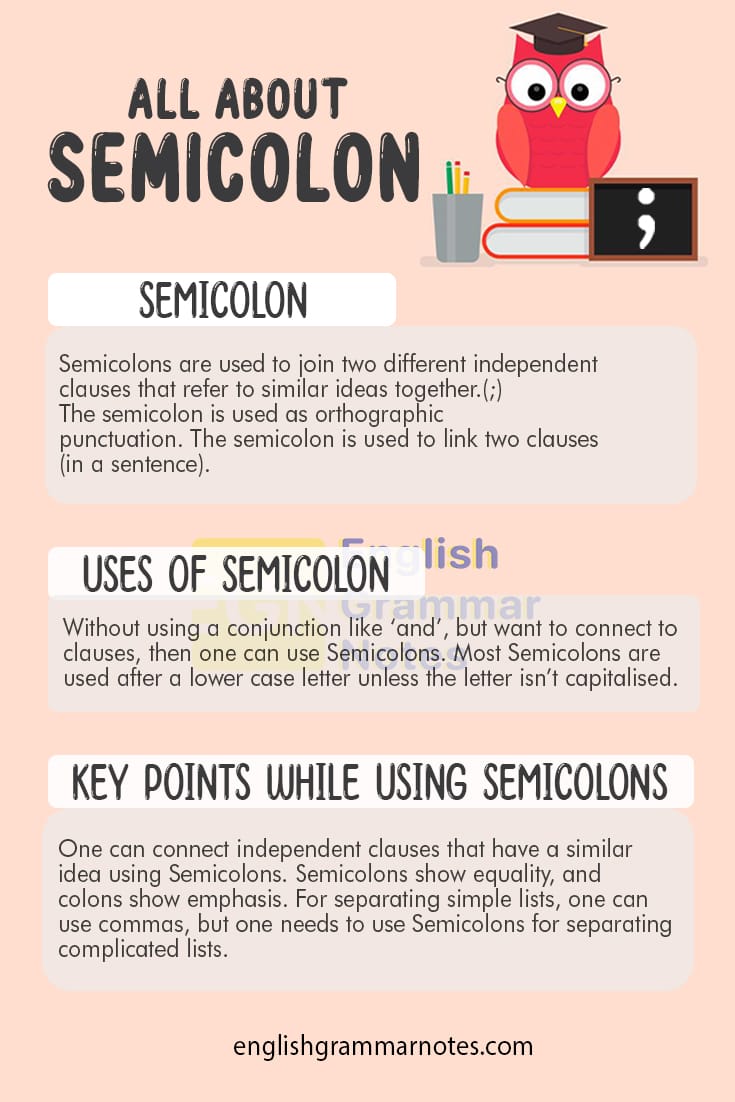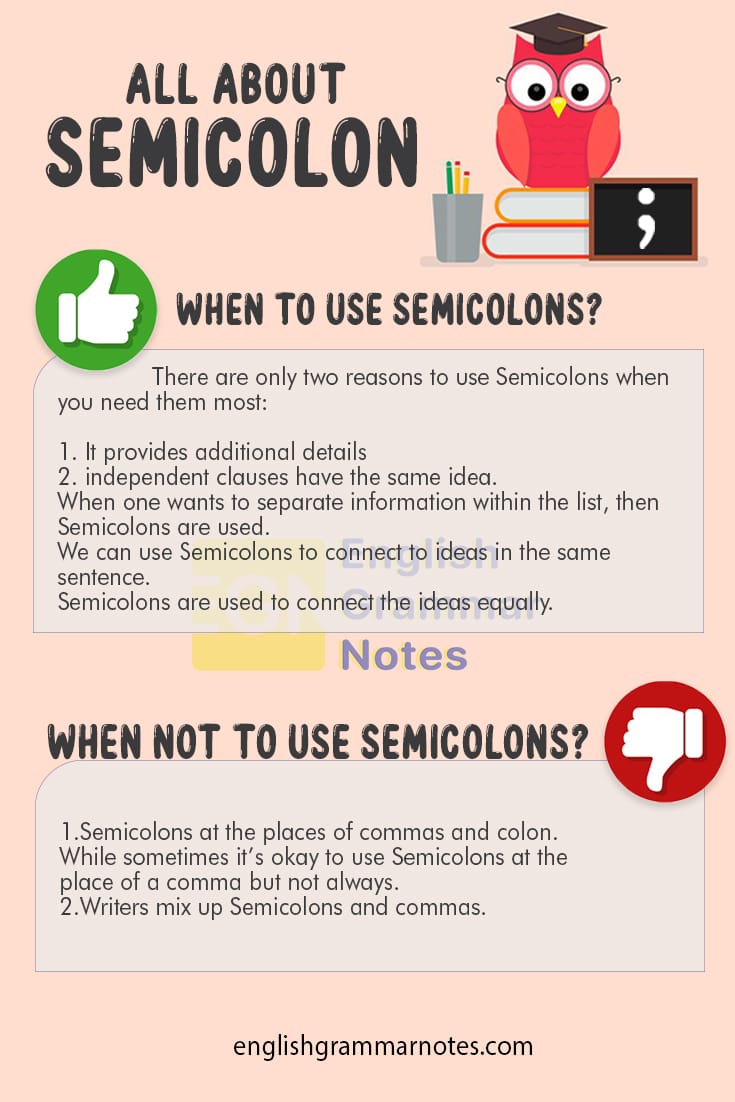Semicolon: There are many punctuation marks in English. One of them is semicolons, which usually confuses not only students but other people too. How and when one can use these semicolons properly. Semicolons look as if full stop over a comma and somewhere. Semicolons follow both the properties of a comma and a full stop. In place of a comma and full stop, one can’t use Semicolons too. As Semicolon (;) is somewhere similar to colons (:) but their uses differ a little bit.
Semicolons have a lot of essential functions. Writers mostly use Semicolons to pause their sentences usually. These pauses are longer than the pauses created by commas, which are shorter than those created by full stops. If you don’t know how to use Semicolons, don’t be scared about that, you can use commas and full stops. After reading this article, you’ll be very free and will have a clear idea about how and where to add Semicolons.
Study the most important English Vocabulary Words identified by our experts and learn the right vocabulary to use in your day to day conversations.
Like colon, semicolons are too confusing, so here we will study how to use semicolons? Where to use semicolons? We will discuss some of the key points and explain all the points so that one gets a clear idea about how to use these semicolons properly. And after reading this article, you’ll have a clear understanding of how and when one can place semicolons (;) correctly.
Understanding semicolons is quite difficult, so we will explain all the different semicolons cases, discuss rules for semicolons, and give examples of how to use semicolons.
- The Semicolons (;)
- History of Semicolons
- Uses of Semicolons
- Other Languages for Semicolons
- Uses of Semicolons in Arabic
- Uses of Semicolons in Greek and Church Slavonic
- Uses of Semicolons in French
- Key points while using Semicolons
- When to Use Semicolons
- When Not to Use a Semicolon
- Is it Necessary to Capitalise the First Letter After the Semicolon?
- How Quotation Marks And Semicolon Are Used Together?
- FAQs on Semicolons
The Semicolons (;)
Semicolons are used to join two different independent clauses that refer to similar ideas together.
(;) It can be named a semicolon. The semicolon is used as orthographic punctuation. The semicolon is used to link two clauses (in a sentence). If two ideas are joined using a semicolon in one sentence, then both ideas get equal importance.
One can use Semicolons in place of commas to separate the items in the list. There are many different types of Semicolons representation examples: Arabic semicolons, Ethiopic Semicolons, Bamum Semicolons. It’s tough to understand the usage of Semicolons, so it’s used the least by many English speakers. It’s mainly used in programming languages as an exterminator or statement separator.
History of Semicolons
Aldus Pius Manutius was the first who printed semicolons in Italian printers in his work. He used these Semicolons to separate the words of opposite meaning, and he also used these Semicolons in connecting the interdependence sentences and Benjamin Jonson was the first to use Semicolons systematically. He was the first notable English writer. Semicolons are majorly used for connecting clauses. Semicolons or semicolons are plurals of semicolons.
At the full stop, exclamation marks and question marks end the sentences. But Semicolons, commas make secondary boundaries in sentences.
Uses of Semicolons
Without using a conjunction like ‘and’, but want to connect to clauses, then one can use Semicolons. Most Semicolons are used after a lower case letter unless the letter isn’t capitalised.
Other Languages for Semicolons
Vasilisa Manqoota (Arabic: فاصلة منقوطة) is the name used in place of a semicolon. Vasilisa Manqoota means a dotted comma. And in Arabic, they use inverted semicolons.
Uses of Semicolons in Arabic
It is used to connect to clauses in such a way that the second clause depends on the first clause. For example, he hasn’t completed the homework, so the teacher scolded him.
It is used to connect to clauses in such a way that the second clause reasons for the first clause. Examples: I love him; because he’s my real hero, my dad.
Uses of Semicolons in Greek and Church Slavonic
The semicolon in Greek and Church Slavonic represents a question mark, similar to the Latin question mark. Semicolons are used very rarely by Greeks.
Uses of Semicolons in French
The Semicolons used by the French are separated between two sentences.
Key Points while using Semicolons
One can connect independent clauses that have a similar idea using Semicolons. One can use Semicolons so that a reader can understand clearly. Semicolons show equality, and colons show emphasis. For separating simple lists, one can use commas, but one needs to use Semicolons for separating complicated lists. Coordinating conjunctions are used with commas, and Coordinating conjunctions aren’t used with Semicolons.

When to Use Semicolons
There are only two reasons to use Semicolons when you need them most: It provides additional details, and two independent clauses have the same idea.
When one wants to separate information within the list, then Semicolons are used.
If there is only a simple list, then colons and commas are okay to use. Still, instead, in sentences that provide additional information about each item in the list, it is necessary to use Semicolons. Semicolons can replace commas, but Semicolons can’t replace colons.
We can use Semicolons to connect to ideas in the same sentence. Semicolons are used to connect the ideas equally, meaning both clauses or ideas have equal importance in a sentence.
When Not to Use a Semicolon
Most people use Semicolons at the places of commas and colon, which is one of the foolish mistakes they make. While sometimes it’s okay to use Semicolons at the place of a comma but not always. So these are some of the major mistakes you can make while using punctuation marks.
Many people mix Semicolons and colons because they are similar in terms of looks and their functioning in sentences.
The easiest way to understand when to use and when to use Semicolons is that colons are only used when one needs to introduce the lists, but the Semicolons can be used in the list or as a part of the list. Whenever we try to connect two independent clauses, emphasis is shown by colons and equality is shown by Semicolons which shows they both are equally important.
The second mistake made by writers is that they mix up Semicolons and commas. If in a list there is additional information, then only a Semicolon is used. A comma is used when there is a simple list. It could be questioned in many minds when connecting to independent clauses why we aren’t using commas at the place of Semicolons. Because Semicolons show that the two are connected and equally important, But Coordinating junction isn’t used between those connected clauses. If you try to use commas instead of Semicolons, then you have to use the coordinating junction.
If there are independent clauses after a dependent clause, then don’t even try to use Semicolons. If there are dependent clauses in a sentence, then do not use Semicolons. If one asks for the reason, then the reason is very simple that it’s not necessary to separate independent and dependent Clauses.

Is it Necessary to Capitalise the First Letter After the Semicolon?
Unless it’s a proper noun, One cannot capitalise the first letter after a Semicolon as a Semicolon is not a full stop. So as you don’t need to capitalise a letter after a comma, the same way, you don’t need to capitalise a letter after Semicolons, and this applies only to ordinary words. But if a word starts with a name of a person or a place, then it is compulsory to capitalise it’s the first letter so, Semicolons functions would not affect this.
Let’s look over dashes and Semicolons
When connecting clauses, dashes only replace colons and Semicolons. For a list, dashes aren’t appropriate. Whenever you want to change dashes with Semicolons or colons, you have to think about whether the informal or formal piece you are writing is.
How Quotation Marks And Semicolon Are Used Together?
Now, you have a base level idea of when to use Semicolons and how to use Semicolons. But what to do when Semicolons and Quotation marks Are together. For introducing quotation marks, one can use colons but can’t use Semicolons for those quotation marks.
According to English grammar, full stop and commas always come inside the quotation marks, but Semicolons lie outside quotations. Most people place Semicolons inside the quotation marks, and it’s incorrect.
The most seen mistakes are writers mixing colons, commas and Semicolons altogether.
FAQ’s on Semicolons
Question 1.
How can we use Semicolons properly?
Answer:
When you want to join two independent clauses related, you can use Semicolons in place of any coordinating conjunction or comma.
Question 2.
Some of the examples of Semicolons?
Answer:
Examples of using Semicolons in sentences are: Saiba likes meat; Anas doesn’t. Only the Semicolons are used when you need something more substantial than a comma in a sentence.
Question 3.
Explain the Function of Semicolons?
Answer:
A Semicolons is mainly used
- when you need to clarify a series
- when you need to indicate two closely related sentences.
Question 3.
Where can we use Semicolons in place of commas?
Answer:
Semicolons are used to connect two independent sentences or independent clauses. In Semicolons, we don’t use coordinating conjunctions, and it can also be used with conjunctive verbs.